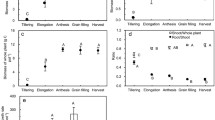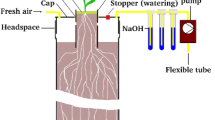Abstract
Perennial rye-grass was subjected to two different14C labelling regimes to enable a partitioning of the carbon sources contributing to rhizosphere carbon-flow. Plant/soil microcosms were designed which enabled rye-grass plants to either receive a single pulse of14C−CO2 or to be pre-labelled using a series of14C−CO2 pulses, allowing the fate of newly photoassimilated carbon and carbon lost by root decomposition to be followed into the soil.
For young rye-grass plants grown over a short period, rhizosphere carbon flow was found to be dominated by newly photoassimilated carbon. Evidence for this came from the observed percentage of the total14C budget (i.e. total14C−CO2 fixed by the plants) lost from the root/soil system, which was 30 times greater for the pulse labelled compared to pre-labelled plants. Root decomposition was found to be less at 10°C compared to 20–25°C, though input of14C into the soil was the same at both temperatures.
Similar content being viewed by others
References
Bowen G D 1980 Misconceptions, concepts and approaches in rhizosphere biology.In Contemporary Microbial Ecology. Eds. D C Ellwood et al. pp 283–304. Academic Press, London.
Curl E A and Truelove B 1986 The Rhizosphere. Chapter 2, pp 9–54, Springer-Verlag, Berlin.
Dalal R C 1979 Simple procedure for the determination of total carbon and its radioactivity in soils and plant materials. Analyst 104, 151–154.
Hansen G K and Jensen 1977 Growth and maintenance respiration in whole plants, tops, and roots ofLolium multiflorum. Physiol. Plant. 39, 155–164.
Jenkinson D S and Powlson D S 1976 The effects of biocidal treatments on metabolism in soil-V. A method for measuring soil biomass. Soil Biol. Biochem. 8, 209–213.
Johnen B G and Sauerbeck D R 1977 A tracer technique for measuring growth, mass and microbial breakdown of plant roots during vegetation. Ecol. Bull. (Stockholm) 25, 366–373.
Keith H, Oades J M and Martin J K 1986 Input of carbon to soil from wheat plants. Soil Biol. Biochem. 18, 445–449.
Lambers H 1987 Growth, respiration, exudation and symbiotic associations: The fate of carbon translocated to the roots.In Root development and Function. Eds. P J Gregoryet al. pp 125–145. Cambridge University Press.
Lee K J and Gaskins M H 1982 Increased root exudation of14C-compounds by sorghum seedlings inoculated with nitrogen-fixing bacteria. Plant and Soil 69, 391–399.
Martin J K 197114C-labelled material leached from the rhizosphere of plants supplied with14CO2. Aust. J. Biol. Sci. 24, 1131–1142.
Martin J K 1977 Factors influencing the loss of organic carbon from wheat roots. Soil Biol. Biochem. 9, 1–7.
Martin J K and Kemp J R 1986 The measurement of C transfers within the rhizosphere of wheat grown in field plots. Soil Biol. Biochem. 18, 103–107.
Minchin P E H and McNaughton G S 1984 Exudation of recently fixed carbon by non-sterile roots. J. Exp. Bot. 35, 74–82.
Rovira A D 1969 Plant root exudates. Bot. Rev. 35, 35–5.
Rovira A D, Foster R C, and Martin J K 1979 Origin, nature and nomenclature of organic materials in the rhizosphere.In The Soil-Root Interface. Eds. J L Harley and R Scott Russell. pp 1–4. Academic Press, London.
Smucker A J M 1984 Carbon utilization and losses by plant root systems.In Roots, Nutrient and Water influx, and Plant Growth. ASA Special Publication Number 49, pp 27–46.
Snellgrove R C, Splittstoesser W E, Stribley D P and Tinker B 1982 The distribution of carbon and the demand of the fungal symbiont in leek plants with vesicular-arbuscular mycorrhizas. New Phytol. 92, 75–87.
Warembourg F R 1975 Application of radio isotopic technique to the study of the biological activity in the plant rhizosphere. Rev. Ecol. Biol. Sol. 12, 261–272.
Warembourg F R, and Billes G 1979 Estimating carbon transfers in the plant rhizosphere.In The Soil-Root Interface. Eds. J L Harley and R Scott Russell. pp 183–196 Academic Press, London.
Whipps J M 1984 Environmental factors affecting the loss of carbon from the roots of wheat and barley seedlings. J. Exp. Bot. 35, 767–773.
Whipps J M and Lynch J M 1983 Substrate flow and utilization in the rhizosphere of cereals. New Phytol 95, 605–623.
Author information
Authors and Affiliations
Rights and permissions
About this article
Cite this article
Meharg, A.A., Killham, K. A comparison of carbon flow from pre-labelled and pulse-labelled plants. Plant Soil 112, 225–231 (1988). https://doi.org/10.1007/BF02139999
Received:
Revised:
Issue Date:
DOI: https://doi.org/10.1007/BF02139999




